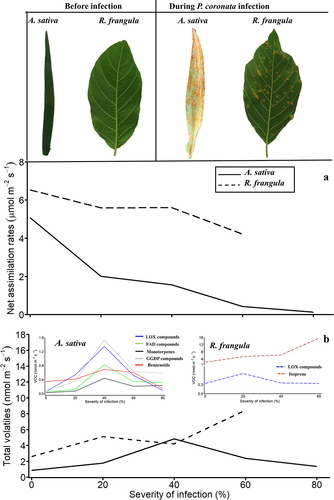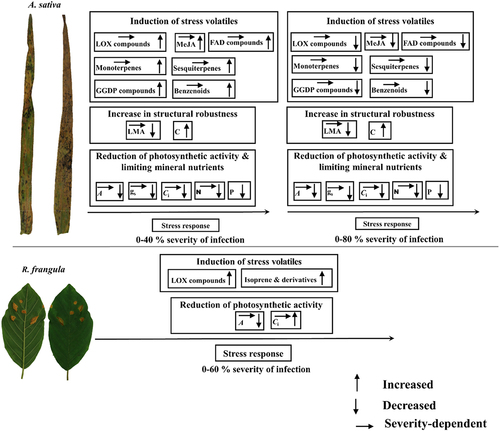Figures & data
Figure 1. Changes in leaf light-saturated net assimilation rate (A) and total volatile emission (B) in the primary host, the annual grass Avena sativa, and the alternate host, the shrub R. frangula, under different severity of the crown rust Puccinia coronata infection. The insets in (B) show the severity-dependent emissions of different volatile groups including short-chained lipoxygenase (LOX) pathway compounds, methyl jasmonate (MeJA), long-chained saturated fatty acid-derived (FAD) compounds, monoterpenes, geranylgeranyl diphosphate pathway (GGDP) compounds and benzenoids in A. sativa and R. frangula. The severity of infection was quantified as the percentage of the total chlorotic and necrotic area of the leaf.

Figure 2. A generalized model of P. coronata infection severity-dependent responses of photosynthetic traits and stress volatile emissions in the primary host A. sativa and alternate host R. frangula. This model shows that the rate of photosynthesis (A) in the primary host is reduced due to stomatal limitations (decreases in stomatal conductance, gs, and intercellular concentrations of CO2, Ci). Reductions in photosynthetic activity are escalated by fungal absorption of limiting mineral nutrients and loss of photosynthetic biomass, indicated by decreases in leaf dry mass per unit area (LMA), due to fungal consumption of leaf biomass. Loss of photosynthetic function is accompanied by accumulation of carbon-rich secondary metabolites e.g. phenolics such as lignin in cell walls that enhances leaf mechanical robustness and reduces cell wall diffusion conductance for CO2. in the alternate host, decreases in photosynthesis are due to reductions in photosynthetic capacity. In the primary host, fungal-induced damages and hypersensitive responses trigger a burst of lipoxygenase (LOX) volatiles and the activation of defense signaling associated with jasmonic acid (JA) accumulation. This leads to the induction of emissions of stress volatiles including mono- and sesquiterpenes from chloroplastic and cytosolic terpene synthesis pathways and benzenoids from the shikimate pathway. Additionally, fungal-induced oxidative stress enhances the release of long-chained saturated fatty acid (FAD) derivatives and geranylgeranyl diphosphate (GGDP) pathway volatiles (carotenoid breakdown products). The emissions of volatiles increase with increasing severity of fungal infection, however, under severe infections, the induction of stress volatiles decreases due to substrate limitation that occurs as a result of inhibition of photosynthesis and cessations of physiological activities in necrotic leaf regions. In the resistant alternate host, due to low oxidative stress, LOX emissions are only elicited to a minor degree. Differently from the enhancement of terpene emissions in A. sativa, in R. frangula, constitutive emissions of isoprene are enhanced upon rust infection, differently from pathogen responses observed in other constitutive isoprene emitters.

